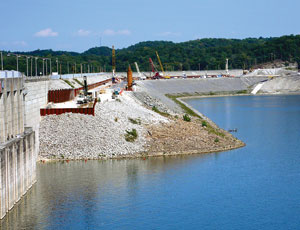In November, installation will begin on the new barrier wall of the Wolf Creek Dam, which the National Dam Safety Program in 2005 gave the highest risk rating for failure.


The $584-million U.S. Army Corps of Engineers Wolf Creek Dam Remediation project in Jamestown, Ky., on the Cumberland River would have come to a screeching halt in July when $54.5 million in fiscal year 2009 funds ran out. But an $18-million American Recovery and Reinvestment Act allocation allowed the Corps and its joint-venture contract team of Treviicos Corp., Boston, and France’s Soletanche Bachy were able to add 33 jobs, with more anticipated, cut the schedule by three months and prove construction techniques so installation of a new barrier wall can begin in November.
“There are many dams throughout the country with similar issues that will require this type of remediation,” says David Hendrix, project manager with the Corps’ Nashville District. Wolf Creek Dam, a 5,736-ft-long, 248-ft-high earth fill structure, is built on seepage-prone permeable karst formations. The dam was completed in 1950. By the 1960s the Corps realized seepage would be a problem, says a Corps spokeswoman.
Remediation calls for a 3,800-ft-long, 6-ft-thick protective concrete embankment wall (PCEW). The contractor will drill through the existing embankment wall and install a new 275-ft-deep wall in sturdier bedrock. The barrier wall will be roughly 50 ft upstream from and 50 ft deeper than the existing wall.
“There have been deep cutoff walls installed at greater depths, and walls installed in harder rock, but our combination of rock hardness and depth is unprecedented,” Hendrix says.
| Jobs Created | Current: 33 More anticipated |
|---|---|
| ARRA Contract Amount | $18 Million |
| Actual Contract Value | $584 Million |
The ARRA funds allowed Treviicos-Soletanche to install a 90-ft- and 100-ft long PCEW in two non-critical areas, test concrete mixes and methods of installing the new barrier wall. The Corps plans to construct the new barrier wall using a combination of 30-in.-wide panels and 50-in.-dia secant piles. After the PCEW is installed, the contractor will drill through that topping into bedrock. “The panel method requires the contractor to drill a rectangular shape all the way down and fill it with concrete,” Jarrett says.
The project is scheduled for completion late 2012.

Post a comment to this article
Report Abusive Comment